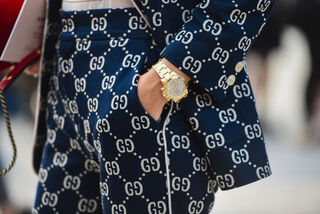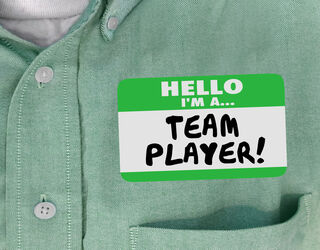Media
Want a Tough Competitor's Aura? Don't Act Too Modest
Modesty can backfire if you want to be viewed as an eye-of-the-tiger competitor.
Posted April 24, 2022 Reviewed by Jessica Schrader
Key points
- New research suggests that displaying modesty on social media is valued by colleagues looking for a cooperative "team player."
- However, modesty works against someone who wants to be viewed as a viable competitor.
- Finding a sweet spot between phony "aw-shucks" modesty and flashy status-signaling is ideal for seeming cooperative and competitive.
"The walking stick serves the purpose of an advertisement that the bearer's hands are employed otherwise than in useful effort, and it therefore has utility as an evidence of leisure." —Thorstein Veblen from The Theory of the Leisure Class (1899)
In 1899, during the second phase of the industrial revolution, Thorstein Veblen introduced the concept of "conspicuous consumption" and "conspicuous leisure" in his book, The Theory of the Leisure Class.
Today, the term "Veblen goods" is used to describe expensive luxury items or wealth-signaling status symbols. But, over a century ago, when factory workers had very little leisure time, carrying an inexpensive walking stick was a subtle way of letting onlookers know that you had plenty of free time and weren't part of the working class. In this context, walking sticks were "Veblen goods."
In the 1890s, walking sticks were a status symbol that meant you were wealthy enough to spend leisure time hiking through the wilderness, far from assembly-line workers and industrial smog. Flash forward to the 2020s, and you'll find lots of so-called "influencers" on Instagram or TikTok using different wealth-signaling strategies to make it appear to onlookers that they're upper crust.

Do People Who Signal Status Seem Less Cooperative?
A recently published University of Michigan research paper (Srna, Barasch, & Small, 2022) explores the value of modesty vs. the social advantages of status-signaling. These findings were published on April 21 in the peer-reviewed Journal of Personality and Social Psychology.
For this multi-pronged study, Ross School of Business researchers started by asking 395 online study participants to evaluate different social media profiles. On one end of the spectrum were neutral posts (e.g., "I saw the cutest puppy today! #goldenretriever) by people who didn't overtly display conspicuous consumption and projected down-to-earth modesty.
On the opposite end of the social media spectrum were aspirational profiles of people who wanted to signal high social status with posts displaying Veblen goods or discussing exotic vacations (e.g., "Heading to Madrid! #firstclass #luxury").

Modesty Makes People Seem Like Cooperative Team Players
As might be expected, study participants rated people with modest social media profiles who weren't trying to signal status as more likely to be "cooperative, selfless and generous." On the flip side, people with ostentatious status-signaling social media profiles were more likely to be viewed as self-interested, narcissistic, and "less likely to care about others."
In another experiment involving a different cohort of 1,345 individuals, study participants were told that recruiters were looking for someone new to join an online team based on a staged photo they'd take in the research lab. Then, researchers gave study participants the choice of wearing luxury brand clothes (e.g., Gucci, Chanel, Louis Vuitton) with prominent logos or non-luxury (e.g., Old Navy, Skechers, Uniqlo) unbranded clothes without statusy logos for the photo.
Half the study participants were told that recruiters wanted someone "extremely cooperative" to join their collaborative team; the other half weren't given any clues about what the recruiters were looking for in a candidate. Unsurprisingly, individuals who thought it would be wise to project "cooperative team player" vibes in their profile pic were much less likely to wear status-signaling Veblen goods.
However, the researchers were surprised to find that, in general, most people chose non-luxury clothing for their profile pics regardless of whether or not they'd been told that recruiters were explicitly looking for a cooperative team player.
"This experiment shows that people are attuned to when the value of luxury logos switches from positive to negative. Not only are people strategic about when to signal status, they are also strategic about modesty," co-author Shalena Srna said in a news release.
Status-Signaling Makes People Seem Less Cooperative But Like Better Competitors
In another somewhat surprising twist, the researchers also found that status-signaling has its advantages in some cases. Although people who tried to signal wealth or status in their social media profiles got low "team player" ratings, they got much higher ratings as "competitive" go-getters.
When participants were asked to choose someone who seemed like they'd give their team an edge over the competition based on a social media profile, they were more likely to select someone who signaled status over someone who signaled modesty.
"Posting about your luxury purchases and expensive vacations on Instagram or TikTok may help you to persuade others, intimidate competitors and succeed on the dating market—at least for men—but it could also signal to potential friends or future employers that you are unlikely to think about the needs of others," Srna noted. "This becomes a tricky balancing act for people who may want to impress others while also demonstrating that they can be a 'team player.'"
A New Englander's View of Frugal "Modesty" vs. "Bourgeois" Status-Signaling
There's a sweet spot between obnoxious, over-the-top status-signaling and trying too hard to project earnest "aw-shucks" modesty. If you want to seem like a cooperative team player who's also capable of having the eye of the tiger, the latest (2022) research suggests that you need to slightly impress people while also seeming humble and modest. Finding this sweet spot is really tricky. Even when people try to appear modest, they might be status-signaling.
For example, my grandparents were New Englanders born at the turn of the 20th century who frowned upon any garish or flashy displays of wealth or materialism. Among their Massachusetts neighbors, it was considered tacky to drive fancy cars or wear anything more luxurious than worn-in Brooks Brothers clothes and L.L. Bean footwear. But again, this aesthetic also signifies a kind of "old money" snobbery that casts anything "bougie" or "nouveau riche" in a negative light.
Along these lines, consciously avoiding Veblen goods because you think they're tastelessly showy conveys its own set of status-related values. The bottom line: Attempting to project modesty simply by avoiding luxury brands and not buying Veblen goods isn't a surefire way to show humility.
In a perfect world, none of us would have to be concerned about how much status or lack thereof we're projecting on social media. But unfortunately, just about everything you post on LinkedIn, Facebook, YouTube, Twitter, Instagram, TikTok, etc., is a signifier. (See, "Semiotics: What It Means, and What It Means to You.")
Going back to Veblen's 1890s observation that, centuries ago, carrying a walking stick was a subtle way to project status. One could speculate that if you want to be viewed as someone who's a cooperative team player and also has the capacity to be a tough competitor, don't take selfies wearing tons of Veblen goods plastered with logos. Instead, find the modern-day equivalent of a status-signaling walking stick that lets onlookers know you've got a competitive streak but are modest enough to take one for the team.
References
Shalena Srna, Alixandra Barasch, Deborah A. Small. "On the Value of modesty: How Signals of Status Undermine Cooperation." Journal of Personality and Social Psychology (First published online: April 21, 2022; DOI: 10.1037/pspa0000303




